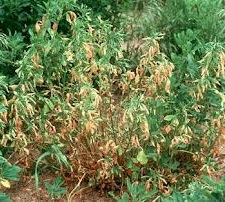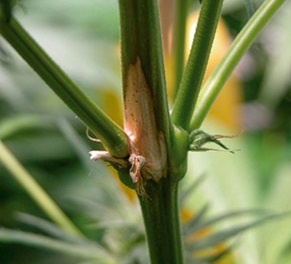
Verticillium wilt happens due to the presence of a fungus, and it occurs most often with marijuana plants in soil that is extremely rich or is not drained properly.
Woody plants with roots that are stressed out are what attract fungi the most, so you should always keep a close eye on all of your plants. Read this article and learn how to recognize and treat verticillium wilt.
Signs of verticillium wilt
Take note of any changes in your marijuana plants. There are certain signs you can see that will indicate that your plant has Verticillium wilt. For instance, the leaves closest to the base of your plant might start yellowing, specifically between the leaves’ veins and on the outside margins.
This is a good indication that your plant is starting to have Verticillium Wilt. The leaves will eventually become a grayish brown color, and your plant will begin to wilt. The stem itself will begin to brown at its base, close to the soil line.
If you are at all familiar with the symptoms that come with Fusarium Wilt, then it is important to note that the Verticillium Wilt symptoms are similar. As soon as the infection has made it all the way to the roots, xylem vessels will clog up and therefore will not allow water or nutrients to be taken in through the stems and leaves of your marijuana plant.
Not sure if your marijuana plants suffer from a infection? Check the article Marijuana diseases for a list with pictures of all possible marijuana diseases
How to get rid of verticillium wilt
As with most conditions, it is crucial that you prevent Verticillium Wilt from ever become a problem for your marijuana plants. One very simple and generally healthy way of preventing a wide number of ailments that could affect your marijuana plants is to amend the soil with some compost that has been aged in the proper way.
Another option is to simply choose to grow your marijuana plants with a hydroponic growing system, but if you are committed to using soil, compost is the way to go. You should make absolutely certain that your composed has been sterilized by the sun. If properly cured and sterilized, compost is the perfect way of naturally giving your plants the support they need to thrive.
Besides compost, having adequate soil drainage is another way of keeping Verticillium Wilt away. Excess moisture is a sure-fire way of encouraging Verticillium Wilt to plague your plants’ root systems. Keep it away by ensuring there is proper drainage in your growing medium.
You can also prevent your plants from getting infected by Verticillium Wilt through crop rotation or deep plowing of your grow site before you plant or transplant your seedlings. After plowing, you should add in some sterilized compost.
If you do notice an outbreak of Verticillium Wilt, you will need to take immediate action. Remove every bit of plant matter that was affected by the infection, but make sure you proceed with caution – spores can travel. With luck, you will be able to get rid of the infection before it affects your entire garden.
Marijuana plant symptoms
Leaf Symptoms:
– Yellowing between veins
– Yellowing of outer margins
– Gray-brown coloring
Plant Symptoms:
– Wilting
– Stem browning near soil line
– Clogging of xylem root vessels
Unfortunately, prevention is basically the only way to deal with Verticillium Wilt at this point – thus far there is no developed way of controlling Verticillium Wilt after it has taken hold or a way of healing the affected plants. Verticillium can remain in the soil for years, meaning that fields that have been infected are considered unsuitable for growing any plants.


0 Comment:
Post a Comment